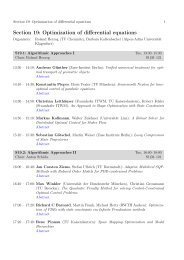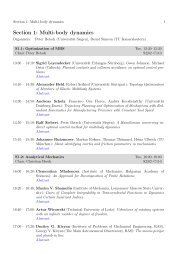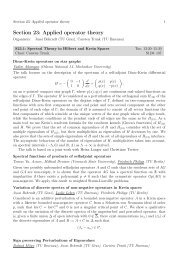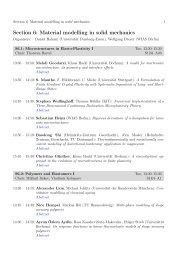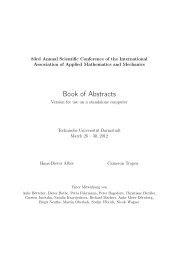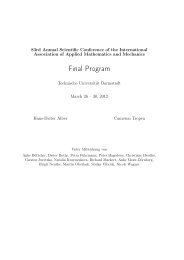Section 6: Material modelling in solid mechanics - GAMM 2012
Section 6: Material modelling in solid mechanics - GAMM 2012
Section 6: Material modelling in solid mechanics - GAMM 2012
Create successful ePaper yourself
Turn your PDF publications into a flip-book with our unique Google optimized e-Paper software.
<strong>Section</strong> 6: <strong>Material</strong> <strong>modell<strong>in</strong>g</strong> <strong>in</strong> <strong>solid</strong> <strong>mechanics</strong> 31<br />
Analysis of nano<strong>in</strong>dentation experiments by means of rheological models<br />
Holger Worrack, Wolfgang H. Müller (TU Berl<strong>in</strong>)<br />
The nano<strong>in</strong>dentation technique, which is similar to the <strong>in</strong>strumented <strong>in</strong>dentation hardness accord<strong>in</strong>g<br />
to MARTENS, is established <strong>in</strong> the field of material characterization at small dimensions.<br />
It is daily practice to analyze nano<strong>in</strong>dentation data with an almost classical formula based on<br />
the publications by Oliver and Pharr and Fischer-Cripps. In this formula the gradient at the<br />
beg<strong>in</strong>n<strong>in</strong>g of the unload<strong>in</strong>g curve is used to determ<strong>in</strong>e Youngs modulus of the tested material,<br />
which is one of the material parameters of <strong>in</strong>terest.<br />
The procedure works well for elastic time-<strong>in</strong>dependent plastic material behavior, for example<br />
copper and the calibration material fused silica, even at higher test temperatures. However, low<br />
melt<strong>in</strong>g solder materials are susceptible to creep behavior, especially at the higher <strong>in</strong>dentation<br />
temperatures where the homologous temperature is > 0.5. As a result of the creep effects the<br />
beg<strong>in</strong>n<strong>in</strong>g of the unload<strong>in</strong>g curve often shows a bulge. This discrepancy from the ideal unload<strong>in</strong>g<br />
curve complicates the correct determ<strong>in</strong>ation of the unload<strong>in</strong>g stiffness and f<strong>in</strong>ally yields to<br />
<strong>in</strong>correct results for Youngs modulus.<br />
For this reason, additional analysis procedures are required to determ<strong>in</strong>e the material parameters<br />
more precisely. In this paper the authors want to give an <strong>in</strong>troduction to an enhanced<br />
analysis of nano<strong>in</strong>dentation data based on rheological models, which are often used to describe<br />
the time-dependence of material response. Two examples of such models are the MAXWELL- and<br />
the KELVIN-body. In these models spr<strong>in</strong>gs and dashpots connected <strong>in</strong> series and/or <strong>in</strong> parallel are<br />
used to describe the time-dependent material response. The viscous parameters, determ<strong>in</strong>ed from<br />
the recorded data dur<strong>in</strong>g the nano<strong>in</strong>dentation experiment, can be used to identify the mechanical<br />
material parameters. The authors present miscellaneous viscoeleastic and viscoplastic rheological<br />
models <strong>in</strong> connection with the correspond<strong>in</strong>g equations which are used to extract the material<br />
properties from the recorded data. Results of the analysis are presented and discussed <strong>in</strong> context<br />
with the results from the classical Oliver and Pharr procedure and with the material parameters<br />
published <strong>in</strong> the literature. F<strong>in</strong>ally, the models are assessed by their applicability of model<strong>in</strong>g the<br />
time-dependent material response of low melt<strong>in</strong>g solder materials.<br />
S6.12: Special <strong>Material</strong> Behavior Thu, 16:00–18:00<br />
Chair: Lurie Sergey, Jaan-Willem Simon S1|01–A1<br />
Carbon Fibre Prepregs: Simulation of a Thermo-Mechanical-Chemical Coupled Problem<br />
F. Hankeln, R. Mahnken (Universität Paderborn)<br />
In automotive <strong>in</strong>dustry research is done to replace high strength steel by comb<strong>in</strong>ations of steel<br />
and carbon-fibre prepregs (pre-impregnated fibres). It is planned to form both steel and uncured<br />
prepregs <strong>in</strong> one step followed by the cur<strong>in</strong>g process under pressure <strong>in</strong> the form<strong>in</strong>g die [1]. The<br />
ability to simulate the mechanical behaviour dur<strong>in</strong>g form<strong>in</strong>g and cur<strong>in</strong>g would allow more economical<br />
processes. The simulation of prepregs must regard highly anisotropic, viscoelastic and<br />
thermal- chemical properties. For this the model is split <strong>in</strong>to an anisotropic elastic part, which<br />
represents the fibre fraction and an isotropic, viscoelastic part, represent<strong>in</strong>g the matrix. This part<br />
also conta<strong>in</strong>s cur<strong>in</strong>g, caus<strong>in</strong>g a dependency on time and temperature. Dur<strong>in</strong>g deep-draw<strong>in</strong>g large<br />
deformations are occurr<strong>in</strong>g, so a large stra<strong>in</strong> model regard<strong>in</strong>g anisotropy[2], viscoelasticity [3]<br />
and cur<strong>in</strong>g [4] has been developed. Also experiments were made to validate this model. Current<br />
progress is the identification of material parameters.



